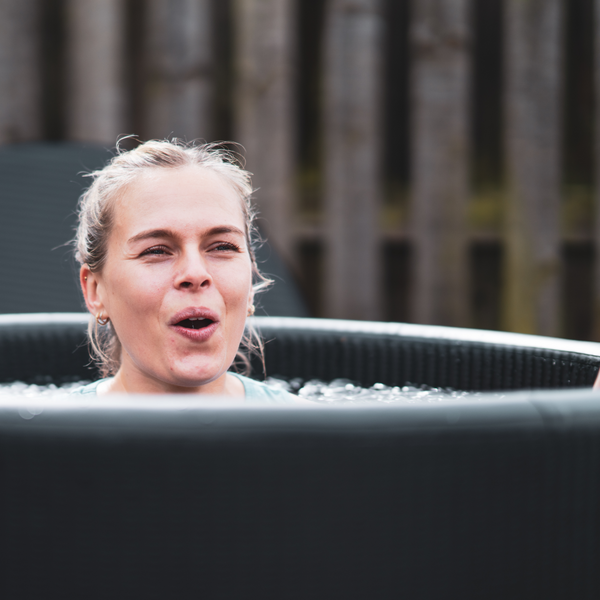Epsom salts are named after the town in Surrey where they were first discovered. They are also a popular remedy for a variety of ailments. It’s because of these health benefits that many people wonder if they can be added to their Cold Pod for an even better experience. In this article, we break down what Epsom salts are, their benefits, and what you need to know about adding them to your ice bath.
What are Epsom salts?
Epsom salts are also known as magnesium sulfate (MgSO4). They are a natural mineral compound of magnesium, sulphur, and oxygen.
Although Epsom salt looks like table salt and dissolves in water, it is a completely different product, so you won’t want to sprinkle the Epsom variety on your chips.
Epsom salts have been used to treat a variety of ailments because it is rich in magnesium, a mineral that many people either lack or are deficient in. And yet, magnesium is crucial for many processes in the body. It’s required for over 300 different chemical reactions and for:
- Muscle contraction
- Communication between nerve cells
- A strong heartbeat
- A strong immune system (Harvard Health Publishing, 2017)
Where were Epsom salts discovered?
Epsom salts have been around for centuries, and they were reportedly first discovered in 1618 in Epsom, Surrey. But before you go rushing off to find the springs in Epsom, they are already widely available in many health foods shops, pharmacies, and online.
They were originally discovered in the healing waters in the town but today they are widely mined from underground deposits. They can also be produced chemically, which means they are available across the world.
What are the benefits of Epsom salts?
Epsom salts are purported to have several health benefits, although the scientific backing for these does vary.
Let’s look at some of the advantages of using Epsom salts.
Magnesium absorption
Magnesium is the fourth most abundant mineral in the body and the second most abundant in the muscles after potassium (Alawi et al, 2018). And because it is involved in over 300 chemical reactions, your body needs it in great supply to keep functioning.
Some people believe that bathing in Epsom salts can help to increase magnesium absorption through the skin. However, there is little scientific evidence to back up this claim. One unpublished study by Waring et al (no date), found that all participants in their study except three had increased blood magnesium levels after bathing in Epsom salt at temperatures between 50-55oC for 12 minutes. The results of the study are unreliable though because no control group was used, and no statistical tests were performed on the results.
Although it may be possible for magnesium to be absorbed through the skin, more conclusive scientific evidence is needed to back up this claim.
Relaxation and sleep
Some research shows that magnesium can promote better sleep (Abassi et al., 2012) and the soothing properties within Epsom salts are believed to help promote relaxation.
A study by Nielsen et al (2010) demonstrated that low magnesium levels in adults aged 51 and above were linked to increased chronic inflammation which could be alleviated through magnesium supplementation. They also found that magnesium intake promoted better sleep.
However, there is no scientific proof that Epsom salts can reverse the effect of low magnesium levels on sleep quality or that the magnesium will be absorbed via the skin.
Exercise recovery
Anecdotal evidence suggests that taking an Epsom salt bath can improve muscle soreness and cramping following exercise.
Research has shown that magnesium is an essential mineral that is involved in energy metabolism, muscle contraction, nerve transmission, and cardiorespiratory functions (Zhang, 2017). Therefore, making it important for exercise.
Some evidence suggests that heat applied after exercise can be effective in reducing muscle soreness because it increases blood flow to the tissues and increases flexibility (Petrofsky, 2017). However, there is little scientific proof that Epsom salts have a direct effect on muscle recovery.
Some athletes may take magnesium supplements because they are prone to low levels, such as women or those who are black or mixed race, or who have a history of Achilles or knee tendon pain (Pollock et al., 2020).
Should I add Epsom salts to my Cold Pod?
Although much of the evidence associated with the benefits of Epsom salts is anecdotal, nothing is stopping you from adding Epsom salts to The Cold Pod. However, Epsom salts are traditionally used in warm baths for muscle soreness.
Adding Epsom salts may enhance your experience and may improve the personal effectiveness of The Cold Pod, but there is no scientific evidence to show that it will have benefits for your recovery.
Considerations when using Epsom salts
If you are using Epsom salts as part of your recovery process, you may need to consider the following:
- If you are deficient in magnesium, relying solely on Epsom salts may not be useful.
- Some people may experience some skin irritation or allergies to some additives, like Epsom salts. You should test a small area of your skin before adding it to The Cold Pod.
- Always follow the instructions on the packet when deciding how much Epsom salt to add to The Cold Pod.
Conclusion
While the benefits of Epsom salts are well publicised, their effectiveness in ice baths isn’t clear and there is little scientific evidence to back up the claims made. However, anecdotal evidence is in abundance, so if you are going to use Epsom salts in The Cold Pod, look out for any personal benefits you may experience and why not let us know?
Sources
Abbasi, B., Kimiagar, M., Sadeghniiat, K., Shirazi, M. M., Hedayati, M., & Rashidkhani, B. (2012). The effect of magnesium supplementation on primary insomnia in elderly: A double-blind placebo-controlled clinical trial. Journal of research in medical sciences : the official journal of Isfahan University of Medical Sciences, 17(12), 1161–1169.
Al Alawi, A. M., Majoni, S. W., & Falhammar, H. (2018). Magnesium and Human Health: Perspectives and Research Directions. International journal of endocrinology, 2018, 9041694. https://doi.org/10.1155/2018/9041694
Harvard Health Publishing (2017). What you should know about magnesium. Available at: https://www.health.harvard.edu/staying-healthy/what-you-should-know-about-magnesium2
Nielsen, F. H., Johnson, L. K., & Zeng, H. (2010). Magnesium supplementation improves indicators of low magnesium status and inflammatory stress in adults older than 51 years with poor-quality sleep. Magnesium Research, 23(4), 158–168. https://doi.org/10.1684/mrh.2010.0220
Petrofsky, J., Berk, L., Bains, G., Khowailed, I. A., Lee, H., & Laymon, M. (2017). The Efficacy of Sustained Heat Treatment on Delayed-Onset Muscle Soreness. Clinical journal of sports medicine: official journal of the Canadian Academy of Sports Medicine, 27(4), 329–337. https://doi.org/10.1097/JSM.0000000000000375
Pollock, N., Chakraverty, R., Taylor, I., & Killer, S. C. (2020). An 8-year Analysis of Magnesium Status in Elite International Track & Field Athletes. Journal of the American College of Nutrition, 39(5), 443–449. https://doi.org/10.1080/07315724.2019.1691953
Waring, R, H et al. (No date). Report on Absorption of Magnesium Sulfate (Epsom Salts) Across the Skin. Available at: https://www.epsomsaltcouncil.org/wp-content/uploads/2015/10/report_on_absorption_of_magnesium_sulfate.pdf
Zhang, Y., Xun, P., Wang, R., Mao, L., & He, K. (2017). Can Magnesium Enhance Exercise Performance? Nutrients, 9(9), 946. https://doi.org/10.3390/nu9090946







